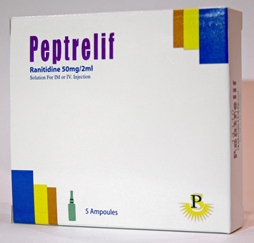
Peptrelif Injection 50 mg/2ml
NAME OF THE MEDICINAL PRODUCT
Peptrelif Injection 50 mg/2ml
QUALITATIVE AND QUANTITATIVE COMPOSITION
Ranitidine Hydrochloride 56.0 mg/2ml equivalent to Ranitidine 50.0 mg/2ml.
PHARMACEUTICAL FORM
Injection (Aqueous solution)
A clear colourless to pale yellow liquid, practically free from particles.
CLINICAL PARTICULARS
Therapeutic indications
Adults:
Peptrelif Injection is indicated for the treatment of duodenal ulcer, benign gastric ulcer, post – operative ulcer, reflux oesophagitis, Zollinger – Ellison Syndrome and the following conditions where reduction of gastric secretion and acid output is desirable:
The prophylaxis of gastrointestinal haemorrhage from stress ulceration in seriously ill patients, the prophylaxis of recurrent haemorrhage in patients with bleeding peptic ulcers and before general anaesthesia in patients considered to be at risk of acid aspiration (Mendelson’s Syndrome), particularly obstetric patients during labour.
Children (6 months to 18 years):
Peptrelif Injection is indicated for the short term treatment of peptic ulcer and the treatment of gastro-oesophageal reflux, including reflux oesophagitis and symptomatic relief of gastro-oesophageal reflux disease.
Posology and method of administration
Adults (including elderly) / Adolescents (12 years and over)
Peptrelif Injection may be given either as a slow (over 2 minutes) intravenous injection up to a maximum of 50 mg, after dilution to a volume of 20 ml per 50 mg dose, which may be repeated every 6 to 8 hours; or as an intermittent intravenous infusion at a rate of 25 mg per hour for two hours; the infusion may be repeated at 6 to 8 hour intervals, or as an intramuscular injection of 50 mg (2 ml) every 6 to 8 hours.
Prophylaxis of haemorrhage from stress ulceration or recurrent haemorrhage:
In the prophylaxis of haemorrhage from stress ulceration in seriously ill patients or the prophylaxis of recurrent haemorrhage in patients bleeding from peptic ulceration, parenteral administration may be continued until oral feeding commences.
In the prophylaxis of upper gastro-intestinal haemorrhage from stress ulceration in seriously ill patients a priming dose of 50 mg as a slow intravenous injection followed by a continuous intravenous infusion of 0.125 – 0.250 mg/kg/hr may be preferred.
Prophylaxis of Mendleson’s syndrome:
In patients considered to be at risk of developing acid aspiration syndrome, Peptrelif Injection 50 mg may be given intramuscularly or by slow intravenous injection 45 to 60 minutes before induction of general anaesthesia.
Children / Infants (6 months to 11 years)
(See Section 5.2 Pharmacokinetic Properties) – Special Patient Populations
Peptrelif injection may be given as a slow (over 2 minutes) i.v. injection up to a maximum of 50 mg every 6 to 8 hours.
Peptic Ulcer Acute Treatment and Gastro-Oesophageal Reflux
Intravenous therapy in children with peptic ulcer disease is indicated only when oral therapy is not possible.
For acute treatment of peptic ulcer disease and gastro-oesophageal reflux in paediatric patients, Peptrelif injection may be administered at doses that have been shown to be effective for these diseases in adults and effective for acid suppression in critically ill children. The initial dose (2.0 mg/kg or 2.5 mg/kg, maximum 50 mg) may be administered as a slow intravenous infusion over 10 minutes, either with a syringe pump followed by a 3 mL flush with normal saline over 5 min, or following dilution with normal saline to 20 mL. Maintenance of pH> 4.0 can be achieved by intermittent infusion of 1.5 mg/kg every 6 h to 8 h. Alternatively treatment can be continuous, administering a loading dose of 0.45 mg/kg followed by a continuous infusion of 0.15 mg/kg/hr.
Prophylaxis of stress ulceration in seriously ill patients
The recommended dose for prophylaxis of stress ulceration is 1mg/kg (maximum 50 mg) every 6h to 8h.
Alternatively treatment can be continuous, administering 125 – 250 micrograms/kg/hr as continuous infusion.
Neonates (under 1 month)
(See Section 5.2 – Pharmacokinetic Properties – Special Patient Populations)
Patients over 50 years of age
See Section 5.2 Pharmacokinetic Properties (Special Patient Populations, Patients over 50 years of age)
Renal Impairment:
Accumulation of ranitidine with resulting elevated plasma concentrations will occur in patients with renal impairment (creatinine clearance less than 50 ml/min). Accordingly, it is recommended in such patients that ranitidine be administered in doses of 25 mg.
Route of Administration
Intravenous or intramuscular injection
Contraindications
Ranitidine is contraindicated for patients known to have hypersensitivity to any component of the preparation.
Pregnancy and lactation
Peptrelif crosses the placenta but therapeutic doses administered to obstetric patients in labour or undergoing caesarean section have been without any adverse effect on labour, delivery or subsequent neonatal progress. Peptrelif is also excreted in human breast milk. Like other drugs, Peptrelif should only be used during pregnancy and nursing if considered essential.
List of excipients
Sodium chloride BP
Potassium Dihydrogen
Orthophosphate HSE
Disodium Hydrogen Orthophosphate HSE
phenol
Water for Injection BP
Shelf life
24 months unopened.
Special precautions for storage
Store at temperature not exceeding 30°c.
Peptrelif Injection should not be autoclaved.
Nature and contents of container
2 ml colourless Type I glass ampoules, Pack size: 5 ampoules.
MARKETING AUTHORISATION HOLDER
Sunny pharmaceutical
Badr City , Cairo,
Egypt
Go to top of the page
Go to top of the page
Go to top of the page
Go to top of the page
Go to top of the page